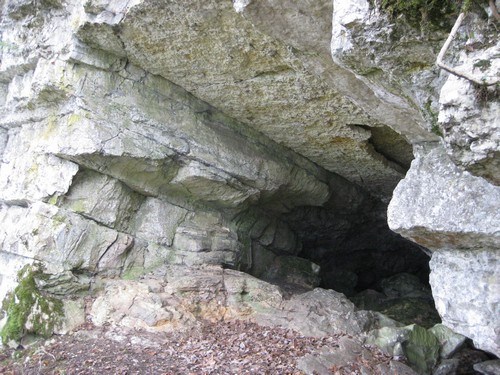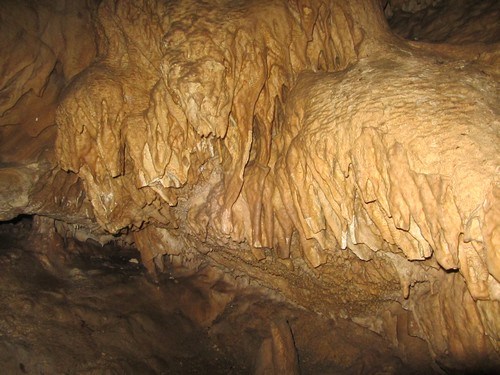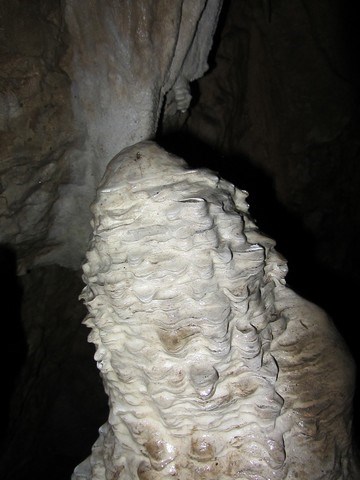Grotte Élisabeth:
A la recherche de la blanche stalagmite
A deux pas de la ville, la grotte Élisabeth ou grotte du bois de peu 2 nous offre la chance exceptionnelle d'admirer 3 phénomènes géologiques : Stalagmite, Stalactite et Draperie.
Formation du terrain&histoire: 
Perchée sur les hauteurs de BEURE, dans le faisceaux bisontin, les différentes grottes dans le secteurs sont composées de calcaire résultant des différents phases géologiques pendant l'ère secondaire et tertiaire.
Au début du mésozoïque (l'ère secondaire -250Ma), la région du Jura est progressivement recouverte d'une mer. Une épaisse couche de marne s'y dépose, mélange d'argile déposé par les fleuves et rivières dans la mer et de calcaire, formé par l'accumulation des squelettes des animaux marins.
Au cours du Jurassique et du début du Crétacé (-200 Ma à -100 Ma), le Jura est une plate-forme océanique peu profonde. Le climat est tropical, une abondante flore marine se développe. Ces conditions sont propices au dépôt d'importantes quantités de calcaire. C'est d'ailleurs en référence au calcaire retrouvé dans le Jura que cette période géologique fut nommée Jurassique.
Vers -100 Ma, les plaques Africaine et Eurasienne entrent en collision, ce qui a pour principale conséquence la formation des Alpes. Cette compression a également pour conséquence secondaire de faire remonter le Jura qui émerge alors. Le jura présente alors un relief de plateau peu élevé.
La plaque africaine continue de pousser vers la plaque Eurasienne. Les Alpes continuent de grandir. Les conséquences des pressions exercées se propagent toujours jusqu'au Jura. Les marnes et calcaires finissent par se plisser (-10 Ma). Les derniers plis peuvent être observés au niveau de Besançon ou Baume-les Dames. On parle du faisceau Bisontin.
C'est dans ces faisceaux,qui représentent des zones très étroites fortement déformées, caractérisées par des décrochements et des imbrication; que peuvent apparaître des grottes.
Source 
http://infoterre.brgm.fr/rapports/RP-55929-FR.pdf
http://www.vinsvignesvignerons.com/Geologie/Geologie/Le-Massif-du-Jura
http://speleo-mandeure.fr/spip.php?article234
http://www.geowiki.fr/index.php?title=Relief_karstique#Les_stalagmites
http://grotte.aguzou.pagesperso-orange.fr/ms4.html
Inventaire spéléologique du DOUBS Tome 2.
La pluie année après année dissout cette roche. Lorsque des cavités sont déjà présentes, l'eau en arrivant au plafond de la galerie, chaque goutte contient un peu de calcaire dont elle abandonne une partie en forme d'anneau avant de tomber.
Puis, une autre goutte lui succède.... Une stalactite se forme peu à peu.
Sur le sol, chaque goutte laisse aussi un peu de calcaire... Une stalagmite se forme.
Il arrive qu'une stalactite et une stalagmite se rejoignent et se soudent: elles forment alors une colonne.
Parfois, la goutte d'eau s'écoule lentement le long d'une paroi oblique en abandonnant peu à peu son calcaire. Les concrétions qui en résultent forment des draperies.
Formation des stalagmites, stalactites et draperies : 
Les stalagmites ainsi que les stalactites se forment grâce à des réactions chimiques acido-basiques : ce sont des réactions caractérisées par le transfert d'un ou plusieurs ion(s) hydrogène H+ entre ses réactifs.
L'air qui entre dans l'aven est chargé de dioxyde de carbone CO2 qui se dissout dans les eaux de ruissellement. Lorsqu'elles traversent les roches calcaires (constitués de carbonate de calcium CaCO3), le CO2 réagit avec les ions carbonate CO32− pour former des ions hydrogénocarbonate HCO3−.
Équation de la réaction :
CO2, H2O + CO32− → 2 HCO3−
Les ions hydrogénocarbonate constituent le solide ionique hydrogénocarbonate de calcium Ca(HCO3)2 qui est soluble dans l'eau contrairement au carbonate de calcium.
Interprétation de l'équation :
La roche calcaire (présente dans les réactifs) est consommée par la réaction chimique ce qui aboutit à la formation de fissures puis de cavernes, étant donné que la roche calcaire se "dissout".
Ensuite, les eaux de ruissellement arrivent dans l'aven chargées d'ions HCO3− mais la particularité de cette espèce est qu'elle est ampholyte. Ainsi elle est capable de réagir avec elle-même et c'est qui se produit. Une espèce ampholyte est une espèce qui constitue la base d'un couple acido-basique et l'acide d'un autre couple.
Équation de la réaction :
HCO3− + HCO3− → CO2, H2O + CO32−
Enfin, lorsqu'une goutte d'eau stagne au plafond ou tombe au fond de l'aven, le dioxyde de carbone qui était dissous quitte petit à petit la solution et les ions CO32− réagissent alors avec les ions calcium (II) Ca2+ (contenus dans le calcaire de la paroi) pour donner du calcaire solide CaCO3 : voilà comment se forment les stalactites ainsi que les stalagmites.
Si la hauteur de chute de l’eau est importante, et si le débit est suffisant, les éclaboussures permettront d’ériger des structures particulières en piles d’assiettes. On peut en rencontrer de magnifiques à l’aven Armand par exemple.
La taille des stalactites et des stalagmites est en rapport avec le débit d’eau et sa hauteur de chute. Si le débit est trop important, les stalactites n’auront pas le temps de se former au plafond. Elles seront de petite taille. Par contre, on aura alors des stalagmites épaisses, massives et impressionnantes.
La température de l’eau est également un facteur entrant dans cette formation, une eau froide favorise la dissolution donc réduit le concrétionnement mais pour une eau chaude, ce sera l’inverse.
Enfin, la présence ou l’absence en surface d’un couvert végétal et donc d’humus, augmente la quantité de dioxyde de carbone présent dans le sol et donc l’acidité de l’eau d’infiltration.
Sources : https://fr.wikipedia.org/wiki/Stalagmite
Exploration de la grotte Élisabeth:
Pour réaliser cette expédition, nous rappelons quelques règles élémentaires liées aux grottes en générale :
NE PAS Y ALLER SEUL. PREVENIR VOS PROCHES DE L'HEURE DE RETOUR PREVUE ET DE DONNER LES COORDONNEES DE LA GROTTE.
Le travail d'équipe ici peut être un confort et une sécurité pour votre expédition alors équipez-vous correctement et organisez votre sortie en équipe!
EQUIPEMENT MINIMUM REQUIS:
-
LAMPE FRONTALE ET UNE LAMPE DE SECOURS.
-
UN CASQUE
-
UNE PETITE CORDE POUR RETROUVER LA SORTIE (5M)
-
PRENDRE DES VETEMENTS QUI N'AURONT PAS PEUR DE SE SALIR 
ATTENTION, LE TERRAIN EST DIFFICILE. UN PETIT PIOLET AINSI QU'UNE CORDE PEUT ETRE UTILE POUR ACCEDER A LA GROTTE PAR TEMPS HUMIDE.
RESPECTER LE LIEU, NE PRELEVER PAS DE STALAGMITES OU DE STALAGTITES.
ATTENTION, IL Y A UN TROU AU FOND DE LA SALLE A GAUCHE. (VOIR PHOTO)
Questions pour résoudre cette Earth:
-
Dites quelle est la période pendant laquelle s'est formé le calcaire de la grotte Élisabeth.
-
Citez au moins trois facteurs entrant dans la formation des stalactites, stalagmite et draperie de la grotte.
-
A l'intérieur de la grotte dans la première salle, vous pouvez observer une stalagmite blanche, déterminer sa hauteur.
-
En option, faire une photo de vous et de la stalagmite (fortement conseillée)
Loguez cette cache "Found it" et envoyez-moi vos propositions de réponses soit via mon profil, soit via la messagerie geocaching.com (Message Center), et je vous contacterai en cas de problème.
![]()

Elisabeth Cave:
In Search of White Stalagmite
A stone's throw from the town, the Élisabeth cave or the wood cave of little 2 gives us the exceptional chance to admire three geological phenomena: Stalagmite, Stalactite and Draperie.
Field Training & History: 
Perched on the heights of BEURE, in the pale beams, the different caves in the areas are composed of limestone resulting from the different geological phases during the secondary and tertiary era.
At the beginning of the Mesozoic (the secondary era -250Ma), the Jura region is gradually covered by a sea. A thick layer of marl is deposited there, a mixture of clay deposited by the rivers in the sea and Limestone, formed by the accumulation of the skeletons of marine animals.
During the Jurassic and early Cretaceous (-200 Ma to -100 Ma), the Jura is a shallow oceanic platform. The climate is tropical, an abundant marine flora develops. These conditions are conducive to the deposit of large quantities of limestone. It is also in reference to the limestone found in the Jura that this geological period was named Jurassic.
Towards -100 Ma, the African and Eurasian plates collide, the main consequence of which is the formation of the Alps. This secondary compression also has the secondary effect of raising the Jura, which then emerges. The jura then has a low plateau relief.
The African plate continues to grow towards the Eurasian plate. The Alps continue to grow. The consequences of the pressure exerted always spread to the Jura. The marls and limestones end up wrinkling (-10 Ma). The last folds can be observed at the level of Besançon or Baume-les Dames. We talk about the Bisontin beam.
It is in these beams, which represent very strongly deformed very narrow zones, characterized by displacements and imbrications; That caves can appear.
Source: 
http://infoterre.brgm.fr/rapports/RP-55929-EN.pdf
http://www.vinsvignesvignerons.com/Geologie/Geologie/Le-Massif-du-Jura
http://speleo-mandeure.fr/spip.php?article234
http://www.geowiki.fr/index.php?title=Relief_karstique#Les_stalagmites
http://grotte.aguzou.pagesperso-orange.fr/ms4.html
Speleological inventory of the DOUBS Volume 2.
The rain year after year dissolves this rock. When cavities are already present, the water arrives at the ceiling of the gallery, each drop contains some limestone of which it abandons a part in the form of ring before falling.
Then, another drop succeeds ... A stalactite is formed little by little.
On the ground, each drop also leaves some limestone ... A stalagmite is formed.
Sometimes a stalactite and a stalagmite come together and are welded together, forming a column.
Sometimes the drop of water flows slowly along an oblique wall, gradually abandoning its limestone. The resulting concretions form draperies.
Formation of stalagmites, stalactites and draperies: 
Stalagmites and stalactites are formed by acid-base chemical reactions: they are reactions characterized by the transfer of one or more H + hydrogen ion (s) between its reagents.
The air entering the aven is loaded with carbon dioxide CO2 which dissolves in the runoff. When they pass through calcareous rocks (consisting of calcium carbonate CaCO3), CO2 reacts with carbonate ions CO32- to form HCO3- hydrogencarbonate ions.
Reaction equation:
CO2, H2O + CO32- → 2HCO3-
The hydrogencarbonate ions constitute the ionic solid calcium hydrogencarbonate Ca (HCO3) 2 which is soluble in water unlike calcium carbonate.
Interpretation of the equation:
The calcareous rock (present in the reagents) is consumed by the chemical reaction, which leads to the formation of cracks and then caverns, since the calcareous rock "dissolves".
Then the runoff water arrives in the aven loaded with HCO3 ions but the particularity of this species is that it is ampholyte. Thus it is capable of reacting with itself and that is what happens. An ampholyte species is a species that forms the base of an acid-base pair and the acid of another pair.
Reaction equation:
HCO3- + HCO3- → CO2, H2O + CO32-
Finally, when a drop of water stays on the ceiling or falls to the bottom of the aven, the dissolved carbon dioxide gradually leaves the solution and the CO32- ions react with calcium (II) Ca2 + ions ( Contained in the limestone of the wall) to give solid limestone CaCO3: this is how stalactites and stalagmites form.
If the drop height of the water is high, and if the flow is sufficient, the splashes will make it possible to erect special structures in stacks of plates. One can meet magnificent ones in aven Armand for example.
The size of the stalactites and stalagmites is related to the flow of water and its height of fall. If the flow rate is too high, the stalactites will not have time to form on the ceiling. They will be small. On the other hand, we will have thick, massive and impressive stalagmites.
The temperature of the water is also a factor entering into this formation, a cold water favors the dissolution thus reduces the concretion but for a hot water, it will be the reverse.
Finally, the presence or the absence on the surface of a vegetal cover and therefore of humus, increases the quantity of carbon dioxide present in the soil and therefore the acidity of the infiltration water.
Sources: https://en.wikipedia.org/wiki/Stalagmite
Exploring the Elizabeth Cave:
To realize this expedition, we recall some basic rules related to caves in general:
DO NOT GO ONLY. PREVENT YOUR NEXT OF THE RETURN TIME AND GIVE COORDINATES OF THE CAVE.
Teamwork here can be comfort and safety for your expedition so equip yourself properly and organize your team outing!
MINIMUM EQUIPMENT REQUIRED:
ATTENTION, THE FIELD IS DIFFICULT. A SMALL PIOLET AND A CORD MAY BE USEFUL TO ACCESS TO THE CAVE IN WET TIME.
RESPECT THE PLACE, DO NOT RETURN STALAGMITS OR STALAGTITIS.
ATTENTION, THERE IS A HOLE AT THE BOTTOM OF THE ROOM TO THE LEFT. (VIEW THE PHOTO)
Questions to solve this Earth:
1. Describe the period during which the limestone of the Elizabeth Cave was formed.
2. Identify at least three factors involved in the formation of stalactites, stalagmite and cave drapery.
3. Inside the cave in the first room, you can observe a white stalagmite, determine its height.
4. Optional, make a picture of you and the stalagmite (strongly advised)
Log in this "Found it" cache and send me your suggestions for answers either via my profile or via the geocaching.com message center, and I will contact you if there is a problem.

Elizabeth Höhle:
Suche nach dem weißen Stalagmiten
Nahe der Stadt, Elizabeth Grotte oder Höhle Holzbohrer 2 bietet uns die einmalige Gelegenheit, geologische Phänomene zu bewundern 3: Stalagmiten, Stalaktiten und
Drapierung.
Schulung & Geschichte: 
Hoch auf den Höhen von BEURE in Besançon Strahlen, die verschiedenen Höhlen in den Sektoren sind aus Kalkstein aus verschiedenen geologischen Phasen für sekundäre und tertiäre Ära.
In den frühen Mesozoikum (Sekundär Ära -250Ma), dann ist der Jura-Region nach und nach von einem Meer bedeckt. Eine dicke Schicht aus Mergel abgelagert wird, eine Mischung aus Ton von den Flüssen ins Meer abgelagert und Kalkstein durch die Anhäufung von Skeletten von Meerestieren gebildet.
Während des Jura und der frühen Kreidezeit (-200 bis -100 Ma Ma) ist der Jura ein flaches Meer Regal. Tropisches Klima, reichlich Meeresflora entwickelt. Diese Bedingungen sind förderlich für große Mengen von Kalksteinvorkommen. Dies ist auch in Bezug auf den Kalkstein im Jura gefunden, dass diese geologische Periode wurde Jurassic benannt.
Um -100 Ma, kollidieren die afrikanischen und der eurasischen Platte, die vor allem bei der Bildung der Alpen führen. Diese Kompression ist auch die Nebenwirkung von Spuren Jura Schwellen dann. Schwor hat dann ein niedriges Plateau Gelände.
Die afrikanische Platte weiter in Richtung der eurasischen Platte zu drücken. Die Alpen weiter wachsen. Die Folgen der Druck immer noch in den Jura zu verbreiten. Marl und Kalkstein schließlich Falten (-10 Ma). Die letzten Falten können in Besançon und Baume-les Dames zu sehen. Wir reden über Bisontin Strahl.
Es ist in diesen Strahlen, die sehr eng stark deformierten Zonen repräsentieren, gekennzeichnet durch Rückschläge und Verschachtelung; das kann Höhlen erscheinen.
Quelle: 
http://infoterre.brgm.fr/rapports/RP-55929-FR.pdf
http://www.vinsvignesvignerons.com/Geologie/Geologie/Le-Massif-du-Jura
http://speleo-mandeure.fr/spip.php?article234
http://www.geowiki.fr/index.php?title=Relief_karstique#Les_stalagmites
http://grotte.aguzou.pagesperso-orange.fr/ms4.html
Inventar der Aushöhlen DOUBS Volume 2.
Regen Jahr für Jahr löst den Fels. Wenn Hohlräume bereits vorhanden sind, Wasser in die Decke der Galerie zu erreichen, enthält jeder Tropfen etwas Kalkstein, den es einige ringförmige aufgibt, bevor fallen.
Dann folgt ein weiterer Tropfen ihn .... Ein Stalaktiten allmählich gebildet wird.
Auf dem Boden, lässt jeder Tropfen auch ein wenig Kalkstein ... Ein Stalagmit gebildet wird.
Manchmal ist ein Stalaktiten und Stalagmiten eine treffen und Sicherung Sie dann eine Spalte bilden.
Manchmal fließt der Wassertropfen langsam entlang einer schrägen Wand allmählich seine Kalkstein verlassen. Concretions resultierende Form Draperien.
Die Bildung von Stalagmiten, Stalaktiten und Draperien: 
Stalagmiten und Stalaktiten werden durch Säure-Base-chemischen Reaktionen gebildet: diese sind Reaktionen, die durch die Übertragung von einer oder mehreren Ionen (n) Wasserstoff H + zwischen reaktiven gekennzeichnet.
Die Luft in den Aven Eintritt ist verantwortlich für die CO2 Kohlendioxid löst sich in den Abfluss. Sie geht durch den Kalkstein (bestehend aus Calciumcarbonat CaCO3), die CO2 reagiert mit CO32 Carbo Hydrogencarbonat-Ionen HCO 3 zu bilden.
Reaktionsgleichung:
CO2, H2O + CO32- → 2HCO3-
Die Wasserstoffionen bilden die starke ionische Calciumhydrogenkarbonat Ca (HCO 3) 2, das in Wasser im Gegensatz zu Calciumcarbonat löslich ist.
Interpretation der Gleichung:
Kalkstein (vorhanden in den Reaktanten) wird durch die chemische Reaktion verbraucht, die von Rissen und Kavernen in der Formation führt, da Kalkstein "gelöst" wird.
Dann Abfluss kommen in HCO3- Ion beladen Schlagloch aber die Besonderheit dieser Art ist, dass es Ampholyt ist. Somit ist es in der Lage mit sich selbst reagieren kann, und es geschieht. Ein Ampholyt Spezies ist eine, die die Grundlage eines Paares Säure-Basen und Säure ein anderes Paar bildet.
Reaktionsgleichung:
HCO3- + HCO3- → CO2, H2O + CO32-
Schließlich, wenn ein Wassertropfen an der Decke sammelt oder auf dem Boden des Schlagloch fallen, das Kohlendioxid, das mit Calciumionen (II) reagieren Blätter nach und nach die Lösung und CO32-Ionen dann + Ca2 aufgelöst wurde ( in der Kalksteinwand enthalten) fester Kalkstein CaCO3 zu geben: das ist, wie Stalaktiten und Stalagmiten zu bilden.
Wenn der Wasserfallhöhe ist wichtig, und wenn die Strömung ausreichend ist, spritzt wird spezifischen Strukturen in Plattenstapel aufzubauen. Wir können Aven Armand Beispiel wunderbar erfüllen.
Die Größe von Stalaktiten und Stalagmiten ist mit dem Wasserfluss und Fallhöhe bezogen. Wenn der Fluss zu hoch ist, Stalaktiten wird keine Zeit haben, um die Decke zu bilden. Klein sein wird. Durch die Nachteile, werden wir dicke Stalagmiten, massiv und beeindruckend sind.
Die Wassertemperatur ist auch ein Faktor in dieser Formation wird ein kaltes Wasser fördert die Auflösung der Ablagerungen verringert, sondern für Warmwasser, wird umgekehrt sein.
Schließlich erhöht das Vorhandensein oder Fehlen auf der Oberfläche einer Pflanze und somit mit Humus abgedeckt, um die Menge an Kohlendioxid, die in dem Boden und damit die Acidität der das Eindringen von Wasser.
Quellen: https://fr.wikipedia.org/wiki/Stalagmite
Erforschung der Höhle Elizabeth:
Um diese Expedition zu erreichen, erinnern wir uns an einige grundlegende Regeln im Zusammenhang mit allgemeinen Höhlen:
NICHT ALLEIN ZU GEHEN. Verhindern, dass Ihr GELIEBTEN planmäßiger Rückkehrzeit und Einzelheiten über die Höhle.
Teamwork kann hier Komfort und Sicherheit für Ihren Versand, wenn Sie richtig ausstatten und Ihre Ausflug Team organisieren!
AUSRÜSTUNG erforderliche Mindest:
- SCHEINWERFER UND LAMP EMERGENCY.
- KOPFHÖRER
- Ein kleines Seil DER EXIT (5M) FINDEN
- Dass Kleidung WILL KEINE ANGST ZU SALIR TAKE

ACHTUNG, das Feld ist schwierig. Ein kleines und ein Seil PIOLET kann nützlich sein, die Höhle WET WEATHER AUFZURUFEN.
Respektieren Sie den Ort auf, nicht NEHMEN ODER Stalaktiten Stalagmiten.
ACHTUNG, da ist ein Loch an der Unterseite von Zimmer. (SEE)
Fragen zu dieser Erde zu lösen:
-
Sagen Sie, was die Zeit ist, während der die Kalksteinhöhle Elizabeth gebildet.
-
. Nennen Sie mindestens drei Faktoren Eingabe in die Bildung von Stalaktiten, Stalagmiten und Draperien der Höhle.
-
Im Inneren der Höhle im ersten Raum, können Sie einen weißen Stalagmiten zu sehen, seine Höhe zu bestimmen.
-
Optional machen ein Bild von Ihnen und Stalagmiten (sehr empfehlenswert)
Melden Sie sich in diesem Cache "Found it" und senden Sie mir Ihre Antworten Vorschläge entweder über mein Profil oder über geocaching.com Messaging (Message Center), und ich werde Sie im Falle von Problemen in Verbindung.
